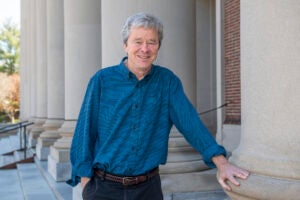Student curators highlight American Indian cultural ‘Remix’
Past, present poise today’s American Indian students for future
“We come to create, rearrange, change, make way for the new day of the native way.”
— from the music of hip-hop artists Quese IMC and 2020
Kelsey Leonard grew up on New York’s Long Island, bombarded by society’s common images of American Indians that included casino owners, alcoholics, and basket-weaving natives.
The images provided confusing and too-often negative guideposts for the young Shinnecock woman, today a Harvard junior.
Last spring, Leonard and three other Harvard American Indian students — Tanner Amdur-Clark, LeRenzo Tolbert-Malcom, and Caitlin Young — tried their own hands at defining American Indian youth in a cultural reality check for those whose only exposure to American Indian culture comes from dated or negative images.
“We are thought of as stagnant, in the past,” Leonard said. “We are cultures that are changing and continually thriving.”
The result is an exhibit at the Peabody Museum of Archaeology and Ethnology titled “Remix: Indigenous Identities in the 21st Century.” Housed in a small gallery at the entrance to the larger Hall of the North American Indian, the exhibit provides a modern counterpoint to the traditional, historical sense of American Indian culture presented by the old artifacts of the larger exhibition.
“There are no birch bark baskets in this exhibit,” said Amdur-Clark, a member of the Citizen Potawatomi Nation. “It’s art of today because we’re people of today.”
“Remix,” which runs through mid-October, provides a thoroughly modern take on American Indian youth culture, featuring four artists whose art ranges from paintings and sculpture to skateboards and T-shirts.
“Our indigenous identities are evolving; it’s not just the bow and arrow or the flute, we have contemporary art forms,” Leonard said. “There’s the idea we’re either extinct or we have to live in two worlds. In reality it’s about finding a balance. You can be the Armani-clad CEO and still be native. And you can be a skater and still have your identity.”
The exhibit features the art of four Native American artists who hail from native communities across the United States: Doug Miles, San Carlos Apache/Akimel O’odham; Ryan Red Corn, Osage; Courtney Leonard, Shinnecock; and Bunky Echo-Hawk, Pawnee and Yakama. Lyrics from rapper Quese IMC run around the top of the exhibit. Quese IMC is Pawnee and Seminole.
“This is showing youth that they don’t have to just take what’s given to them. If they want Geronimo on a skateboard, they can have it,” Leonard said.
Simone Monique Barnes, who works at the Peabody as part of Harvard’s Administrative Fellows Program, guided the students’ work. The exhibit, she said, fits into a new emphasis at the museum on collaborative exhibits concerning American Indians. This emphasis reflects a major paradigm shift over the past 20 years that changes how indigenous collections are cared for and exhibited, with museums seeing themselves as stewards to collections and valuing community, scholar, and student contributions to the curatorial process.
Assistant to the President and Associate Vice President James Hoyte, who heads the Administrative Fellows Program, said the program, begun nearly two decades ago, aims to promote diversity at the University by bringing talented people from minority groups into Harvard’s administrative ranks.
Barnes said the students determined the content, aided by Barnes and the museum. The exhibit, which was financially supported by the University, was supported artistically by the artists themselves, who created several new pieces for the project.
“[The student curators] really wanted something that represents youth identity and modern identity. Native American youth will see themselves in these pieces in a way they don’t in other exhibits,” said Barnes, whose background includes Cherokee, Huron, and Blackfoot. “They’re going to see things inspired by the past but not buried by it.”
One piece, a wall painting by Ryan Red Corn titled “Vandalism,” reflects a native point of view of one of the nation’s most symbolic monuments: Mount Rushmore. Carved into the stone of the Black Hills, which are considered sacred by the Lakota, the monument presents images of four presidents whose legacy among American Indians is very different from that in mainstream society: that of a town destroyer, the creator of the “Trail of Tears,” an executioner, and the instigator behind the conversion of tribal lands to national parks.
The painting incorporates an exchange overheard between a child and parent who came into the hall as Red Corn was working — “I hope there are no Indians here,” the child said. “Don’t worry, there is not,” The parent responded.
The exhibit, which opened April 5, was timed to coincide with the 5th Annual Ivy Native Council Conference, hosted at Harvard that same month. The Ivy Native Council is an organization of American Indian student groups at Ivy League schools, such as Native Americans at Harvard College, which sponsored the exhibit along with the Peabody.
Leonard, who was president of Native Americans at Harvard College last spring, said she remembers the positive feelings from her first Ivy Native Council Conference and wanted the conference at Harvard to be special. In talking with other organizers, she realized that art, so important to the American Indian community, was not represented at other conferences. That was when the 2008 conference organizers decided to highlight contemporary art as a way to both appeal to youth and open the eyes of people whose only exposure to native communities has been through mainstream media.
“We realized that art was not there before,” Leonard said. “It’s important to highlight [the importance of art in American Indian culture] to others looking in on our culture.”




